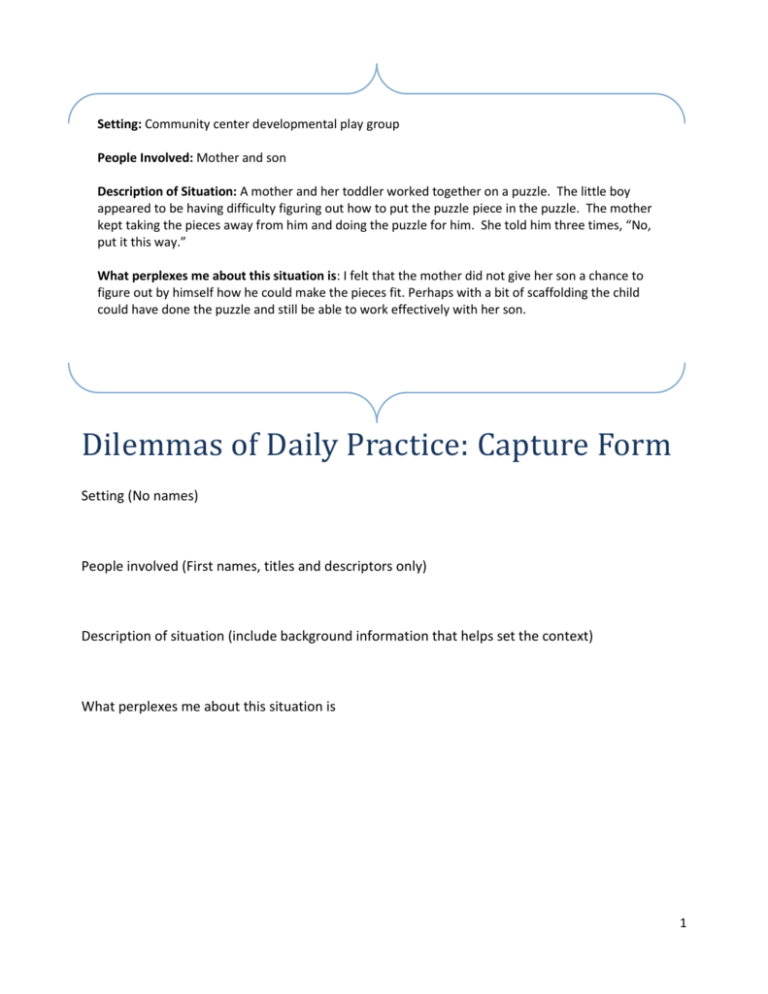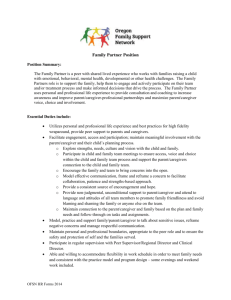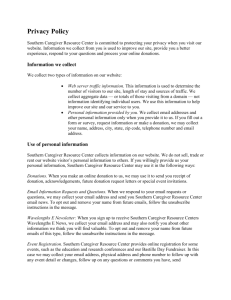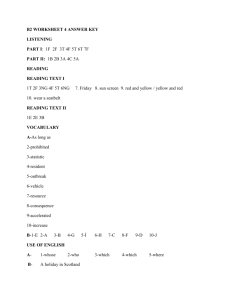EBP_dilemmas of daily practice_resources handout
advertisement

Setting: Community center developmental play group People Involved: Mother and son Description of Situation: A mother and her toddler worked together on a puzzle. The little boy appeared to be having difficulty figuring out how to put the puzzle piece in the puzzle. The mother kept taking the pieces away from him and doing the puzzle for him. She told him three times, “No, put it this way.” What perplexes me about this situation is: I felt that the mother did not give her son a chance to figure out by himself how he could make the pieces fit. Perhaps with a bit of scaffolding the child could have done the puzzle and still be able to work effectively with her son. Dilemmas of Daily Practice: Capture Form Setting (No names) People involved (First names, titles and descriptors only) Description of situation (include background information that helps set the context) What perplexes me about this situation is 1 Early Childhood Dilemmas of Daily Practice 1. “It is WAY too cold for my child to be outdoors. My mom told me that if you take your child out when it’s this cold they will get sick for sure.” (68 degrees and sunny) This is a family belief that is passed from generation to generation. 2. An African American mom doesn’t want her child playing in the sand (for fear of the sand getting in the child’s hair). The teacher says that the curriculum is play based and that includes allowing children to play in the sand so she won’t keep the child out of the sand. 3. A kindergarten teacher put the children’s crayons (that they bought for their school supplies) and grouped them by color – all the reds together, all the blues, etc and had the children share. A parent in the room was upset that her child had to share the crayons she bought for her child. The parent is valuing independence and the teacher is operating out of collaborative model and the Reggio curriculum model. (Source: Bridging Cultures, Teacher Education Module) 4. A parent of a kindergarten child walks the child into her classroom every day. The parent struggles to say goodbye. The teacher is patient in the beginning. By October the teacher is encouraging the parent to drop the child off at the front of the school and let the child walk into school with her friends. The parent continues walking the child into class. The teacher is discouraged and feels the child is not developing skills of independence. 5. The parent of a child with a disability consistently communicates with the paraeducator and makes special requests. The parent does not talk directly with the teacher but asks the paraeducator to handle situations or to pass a message onto the teacher. 6. Many of the children didn’t pass the communication section of the ASQ3 (an assessment tool). The children were speaking the way their children spoke but not the way the ASQ3 expected for their age. The ASQ 3 requires the children use the following words in their sentences: “a”, ‘the”, “am”, ‘Is” “are”. Also the ASQ3 assesses whether children use the appropriate word endings such as “ing”, “s” , “ed”. For example children said “I ginna go to the store” Or “He be messn’ with me” 7. A child is new to the program and is in foster care. He has never participated in a social setting with other children. He has behavioral issues and functions at 12 months below age level. Other parents in the classroom see there are issues and do not want their child in the same classroom with this child. 8. A family who does not want their son to dress up in dresses, color with pink or purple markers or play the Dora Explorer Program on the computer. The Dora program is in Spanish and the parents think we should not allow Spanish speaking at school. 9. A kindergartner’s father is in prison, mom died and a young aunt in her early 20’s has custody of the child. The aunt does not speak English and brings a 7th grade cousin to the meeting to act as the interpreter. 10. The center has a family from Vietnam in the program. They are concerned that the local tap water is over chlorinated. They will only allow their daughter to drink bottled water. 11. A nursery program at a local church has a policy that a male cannot be left alone with the infants. But a female can be left alone. Does this seem discriminating against the male? 2 Selected Dilemma Strategies 1. Her space isn’t my space – this strategy asks students to examine the dilemma and identify the dimensions of culture that may be in conflict in the dilemma. 2. What would my elders say – this strategy asks students to explore early memories of wisdom of their elders. What sayings, words of advice might be of assistance in this dilemma in the present? 3. What would my readings say – this strategy asks students to use their readings for guidance. This can be done as individuals, in pairs, or in small groups. Students go to assigned readings and find specific quotes that might relate. 4. What does the evidence say - this strategy asks students to explore the evidence base for the solution to a dilemma. This can be done as individuals, in pairs, or in small groups. Students go to diverse sources for best available research, professional wisdom, and family wisdom to find relevant sources. 5. If I believed that, what would I do – this strategy uses an explicit set of philosophical statements, such as those guiding a program, and asks the student to examine the dilemma in the light of the philosophy. 6. What would you do? - this strategy uses a piggybacking approach. Dilemmas are passed around the room anonymously. Each individual adds a thought, until ideas have been exhausted. The completed sheet goes back to the original problem poser. 7. How can I? - this strategy asks the student to develop a reframed problem statement, in which they reduce blaming and put themselves in the center of the solution. 8. That reminds me of – this strategy asks the student to tap into early memories. Probes such as “how did this dilemma make you feel? Can you recall an early time when you felt that way?” Having made a connection to the early memory, the student is asked to reflect on a new view of the dilemma. 9. Just the facts, ma’am – in this strategy, students are asked to look at the dilemma and to very carefully sort facts from assumptions, then to address the facts as the problem. 10. What was he thinking – in this strategy, students develop a t-chart in which they identify how each of the parties in the dilemma might have experienced the dilemma. 11. We all have strengths – in this strategy, students develop a t-chart in which they identify the strengths that each of the parties in the dilemma might be bringing to the dilemma. 12. The great debate – identify two distinct options for how to address the dilemma. Divide participants into two groups and assign each group to one option. Ask each group to “make the case” for their option. Present the two positions in a mock debate format in which each side presents their “arguments” and also gets on minute for “rebuttal”. 3 Follow-up Questions for Action Planning And knowing what you know now, what new meaning do you make of this dilemma? What might you do in your role as a reflective early childhood professional? 4 On the One Hand—On the Other Hand Dilemma On the one hand #1 A family hates to see their child messy. They believe that clothes indicate the quality of the family. They believe that they are sending their child to “school”, and the child who goes to school clean and well-dressed shows the parents’ respect for education. It is very upsetting to them when their child is picked up wearing clothes full of grass stains, food, or fingerpaint. They cannot accept the suggestion of sending their child to school in old clothes; it doesn’t fit in with their image of decency. A baby can’t sleep alone, and gets very upset when put into a crib by himself. He comes from a large family and is used to sleeping the midst of activity. #2 #3 #4 Several families in the child care setting want their babies to be held all the time, not put down on the floor. They believe that human relationships, established through constant contact and interaction, are more important than playing with objects and being on the floor. A parent maintains that her one-year old is toilet trained. At home the baby does not wear diapers or complicated clothing. Opportunities to use the toilet are provided regularly by the mother at home; thus the baby has few or no “accidents”. The parent expects the same arrangement in the child care setting. On the other hand Possible strategies for resolving these differences (what would you do?) A caregiver provides messy sensory activities. She feels strongly about the importance of sensory experiences as part of play, learning, and development. A caregiver believes that babies should sleep alone in a crib—tucked away in a relatively dark, quiet spot (the nap room). Licensing agrees. At first the caregiver thought that the baby would get used to the center’s approach, but he didn’t. He becomes distraught and refuses to sleep when he is put into a crib in the nap room. A caregiver keeps putting babies on the floor to play with objects and toys. She knows that safety issues are a big concern, as well as dirt, germs, and drafts. She knows that in some homes the floor isn’t a safe place for babies. She is determined to educate the parents about the value of freedom of movement. The caregiver feels certain that the parent is trained, not the baby. To the caregiver, a child must be old enough to go to the toilet independently, wipe, wash hands, and so forth. The caregiver feels strongly that she has neither the time nor the relationship with the baby to use the family’s techniques in the care setting. 5 Situation #1 What REALLY happened next Resolution came through understanding and negotiation, with both parties seeing the other’s perspective and both parties compromising. The caregiver educated herself. She went to some trouble to find out why being clean was so important to this family. It took lots of talking before she found out that this family had had an experience with Child Protective Services accusing a neighbor of neglect because her child often looked dirty. While the caregiver was getting educated, she was also educating the parents about the importance of sensory experiences. Finally, they came to an agreement that the caregiver would change the clothes of the child during messy play, or at least make very sure she was covered up, so that when the parents returned they would find their child as they left her. The parents were not completely convinced that messy experiences were important, but they said it would be okay as long as their daughter’s clothes weren’t involved. The caregiver continued to think that they were overly concerned about appearances, and neither side gave up on reforming the other side. How do you feel about this approach? #2 Resolution came through caregiver education. The caregiver discovered that the baby went to sleep easily in the play area on a mattress with other children snuggling or playing around him. The caregiver had no objection to letting him nap in the play area, but that approach to napping was against regulations. Once the caregiver saw the family’s perspective, she was convinced that licensing needed to change, not the family. She was able to get a waiver once she convinced them that she was only able to fulfill the spirit of the regulation—that each child has a right to undisturbed sleep—if she didn’t isolate the child in the nap room. How do you feel about this approach? #3 Resolution came through parent education. The caregiver worked with the families to clarify their goals for their children, leading the families to realize that freedom to move was vital to their children’s development. She showed the parents how their children would be safe on the floor by having immobile babies fenced off from the mobile ones. How do you feel about this approach? #4 There was no resolution. Although the caregiver didn’t change her own approach to toilet training, she was respectful of someone who did something different from what she did. She was accepting of the difference, rather than feeling angry or superior to the family members. Though unresolved, the conflict was managed by both parties. The mother continued to “catch” her child at home, and put diapers on when she was in day care. Neither the parent nor the caregiver felt entirely satisfied, but both parties managed to cope and weather it through until the child was old enough to become independent in her toileting. How do you feel about this approach? Created by Camille Catlett (catlett@mail.fpg.unc.edu) based on the following article: Gonzalez-Mena, J. (1992, January). Taking a culturally sensitive approach in infant-toddler programs. Young Children, 47(2), 4-9. 6








